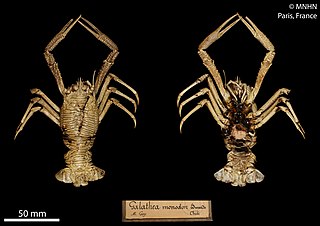Related Research Articles

Munidopsis serricornis is a species of squat lobster. It is widely distributed in the world's oceans, being found in the eastern Atlantic Ocean, the western Atlantic Ocean, and the Indo-Pacific. It grows up to a carapace length of 20 millimetres (0.8 in).
Uroptychus is a genus of squat lobsters in the family Chirostylidae found across the Indo-Pacific. The genus Uroptychus contains the following species:
Anomoeomunida caribensis is a species of squat lobster in a monotypic genus in the family Munididae.
Anoplonida is a genus of squat lobsters, which are flattened dorsoventrally, in the family Munididae, containing the following species:

Babamunida is a genus of squat lobsters in the family Munididae, containing the following species:
Enriquea leviantennata is a species of squat lobster in a monotypic genus in the family Munididae.

Heteronida is a genus of squat lobsters in the family Munididae, containing the following species:

Lauriea is a genus of squat lobsters in the family Galatheidae, containing the following species:
Neonida grandis is a species of squat lobster in a monotypic genus in the family Munididae.

Pleuroncodes is a genus of squat lobsters in the family Munididae, containing the following species:
Setanida cristata is a species of squat lobster in a monotypic genus in the family Munididae.

Shinkaia crosnieri is a species of squat lobster in a monotypic genus in the family Munidopsidae. S. crosnieri lives in deep-sea hydrothermal vent ecosystems, living off of the chemosynthetic activity of certain bacteria living on its setae.
Tasmanida norfolkae is a species of squat lobster in a monotypic genus in the family Munididae.

Torbenella is a genus of squat lobsters in the family Munididae, containing the following species:
Munidopsis tuberosa is a species of squat lobster, first isolated from deep waters off Taiwan. M. tuberosa is similar to M. granosicorium, but it differs by the configuration of its carapace and rostrum.
Munidopsis echinata is a species of squat lobster, first found in deep waters off Taiwan. M. echinata is similar to M. colombiana, but differs by lacking an antennal spine on its carapace and having a rather longer antennal peduncle.
Eumunida chani is a species of chirostylid squat lobster first found in Taiwan. This species can be distinguished by its absence of a pad of densely distributed setae on its first pereopod, the anterior branchial margin which bears two spines, and the carpus of its first pereopod carrying only two spines.
Uroptychus anacaena is a species of chirostylid squat lobster first found in Taiwan. U. anacaena and U. anatonus are similar but can be distinguished from each other by the shape of their 4th sternite and the length of their antennal scale. Both species resemble U. maori and U. brucei, but lack a ventral subterminal spine on their first pereopod's ischium.
Uroptychus orientalis is a species of chirostylid squat lobster first found in Taiwan. This species is separated from U. occidentalis by its shorter antennal scale and dactyli P2–4 with their ultimate and penultimate spines being subequal in size.
Uroptychus singularis is a species of chirostylid squat lobster first found in Taiwan. This species is distinguished from U. australis by its single, unpaired terminal spine on its flexor margin of pereopods 2–4.
References
- ↑ Baba, Keiji, and Chia-Wei Lin. "Five new species of chirostylid crustaceans (Crustacea: Decapoda: Anomura: Chirostylidae) from Taiwan." Zootaxa 1919 (2008): 1-24.